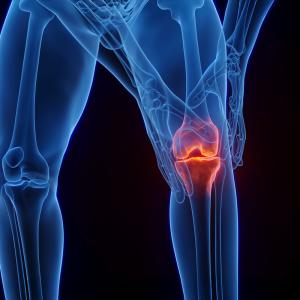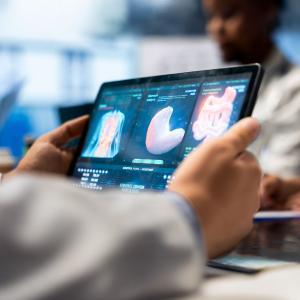
Orthopedic surgeons Dr. Omri B. Ayalon and Dr. Jacques H. Hacquebord, co-directors of the Center for Amputation Reconstruction, used leading-edge surgical techniques and prosthesis technology to effectively treat necrosis in a patient’s forearm.
Photo: NYU Langone Staff
When a patient recovering from coronavirus disease (COVID-19) experienced necrosis of his entire forearm associated with a virus-induced blood clot, an experienced team of experts at NYU Langone’s Center for Amputation Reconstruction planned a two-stage surgery balancing amputation with optimization of functional outcome. Relying on purposeful collaboration aligning advanced surgical approaches and prosthesis technology, the team successfully resolved the patient’s condition while preserving his independence and quality of life.
An Extreme Case of Virus-Associated Coagulopathy
The 76-year-old patient was previously hospitalized for more than 2 months for severe COVID-19 infection and associated complications. While in critical condition in the intensive care unit (ICU), he developed a subclavian blood clot that obstructed blood flow to his left hand and forearm. At that time, the clinical team took a life-over-limb approach focused on his recovery from COVID-19 without further comorbidities. Once the patient was stable, he was referred for consultation with a team at the Center for Amputation Reconstruction, co-led by Omri B. Ayalon, MD, clinical assistant professor in the Department of Orthopedic Surgery, and Jacques H. Hacquebord, MD, assistant professor in the Department of Orthopedic Surgery and the Hansjörg Wyss Department of Plastic Surgery.
“This patient had an extreme case of the coagulopathy that emerges in a substantial number of patients with COVID-19,” notes Dr. Hacquebord. “His arm was mummified, and since the necrosis of the hand and distal forearm was evolving, we followed him closely over a period of weeks to allow the level to demarcate before recommending amputation.”
Deliberate Planning, Reconstruction Turn Amputation to Treatment
While amputation was long considered a last-resort failure of treatment when other options are exhausted, Dr. Hacquebord and Dr. Ayalon approach the technique with an eye toward reconstruction, maximizing functional anatomy while eliminating nonviable tissue. This patient’s engagement with the multidisciplinary team at the center enabled deliberate, function-sparing planning at each phase of treatment.
“Here, our early evaluation of the patient’s condition in the ICU, combined with the multidisciplinary expertise of our surgical team, prosthetist, occupational therapist, and mental health specialist, allowed us to plan thoughtfully, with everyone lending their individual expertise to one collective, targeted outcome.”—Omri B. Ayalon, MD
“Often, these procedures are performed urgently, which puts the team in a position of playing catch-up with reconstruction and functional restoration,” notes Dr. Ayalon. “Here, our early evaluation of the patient’s condition in the ICU, combined with the multidisciplinary expertise of our surgical team, prosthetist, occupational therapist, and mental health specialist, allowed us to plan thoughtfully, with everyone lending their individual expertise to one collective, targeted outcome.”
First, Dr. Hacquebord and Dr. Ayalon worked in tandem with the team prosthetist to determine the salvageable limb length they had to operate with, balancing surgical options with prostheses that carried certain length requirements. “We wanted to preserve the elbow, which would increase the patient’s function considerably,” adds Dr. Ayalon. “So the first stage was to plan a pedicled abdominal flap method to reach that extra length.”
With that approach in mind, the team secondarily sought to preserve the greatest possible function by applying a bone bridge for stability, identifying the correct nerve transfers to utilize in order to bypass nonfunctional nerves, and reinnervating muscles to reduce phantom limb sensation and accommodate future myoelectric prosthesis use. The complex plan required two surgeries and extensive rehabilitation, but the patient was highly motivated with a good support system in place, notes Dr. Hacquebord.
“Patients’ lives are affected tremendously by having an amputation, and depression, anxiety, and post-traumatic stress can present a significant roadblock to recovery and rehabilitation,” he says. “We prioritize mental health in patients’ treatment plans because it’s one of the most overlooked factors—yet it’s just as important as their physical therapy and recovery.”
Two-Stage Approach Expands Prosthesis Options
The first-stage surgery began with osteotomy of both the radius and ulna, with a free segment of ulna clamped between the bone shafts to provide stability for a future prosthesis. Screws were placed across cortices to provide bone fixation, and the bone was covered as completely as possible with dorsal musculature and healthy, viable skin.
Though much of the area’s tissue and nerves were assumed necrotic, the patient’s bone health supported an extension of the amputation by up to six inches using the pedicled abdominal flap technique. In the first stage, the flap was drawn, dissected, and raised off the fascia; then the patient’s arm was adducted to his side and the flap inset with sutures. The base of the flap was closed before inset to provide substantial coverage in anticipation of the second procedure three weeks later. At that time, the flap was divided, debulked, and inset on the extremity.
With the flap placed and the abdomen closed, targeted muscle reinnervation began with exposure and lysis of the median nerve, ulnar nerve, and musculocutaneous nerves. The nerves were found to be more necrotic than expected, prompting the surgical team to adjust the surgical plan intraoperatively and focus more proximally in the brachium as opposed to the forearm to preserve the patient’s elbow flexion and extension strength. Nerve transection was performed across the branches of the biceps, and nerve coaptations were completed and observed to be consistent with the prior transfers. The areas were sealed, and the patient was moved to recovery.
Coordinated Approaches Yield Successful Outcome Beyond Surgery
The patient’s rehabilitation is ongoing, and he has experienced steady improvement of prior nerve pain and phantom limb sensation, maintaining some function with the remaining extremity alone. He has been fit for a prosthesis, and following further healing, he will work with the center’s prosthetic experts to fine-tune its myoelectric signals for optimal function as he learns to use it. He works with the center’s dedicated hand therapist, who applies advanced, amputee-focused approaches to help him strengthen his remaining arm and its function.
“Our multidisciplinary interventions mean the difference between a longer or shorter extremity, a greater- or lesser-functioning prosthetic, and a higher or lower quality of life for our patients,” notes Dr. Ayalon. “While each of these surgical approaches and techniques may be available individually, we offer a truly unified approach with every possible combination of optimal treatments tailored for the benefit of these often overlooked patients.”

